About UVA Health System
University Highlights
The University of Virginia Health System is one of only a few academic medical centers in the United States where the hospital and inpatient care facilities, along with many outpatient clinics, are located side-by-side with the medical and nursing schools, and contiguous with the main University campus (“Grounds“) in Charlottesville. At UVA, you can see Jefferson’s historic and beautiful “Academical Village“, with its Rotunda and Lawn, as well as much of the rest of the University campus, from many vantage points on upper levels of the University Hospital. Learn more about UVA here: Facts & Figures at a Glance.
The UVA Health System strives to continually expand in all of our missions − patient care, education, and research. To support this, we are actively engaged in improving our physical facilities, recruiting and retaining excellent faculty and staff, expanding our clinical programs, strengthening our recognized centers of excellence, and streamlining our healthcare delivery processes.
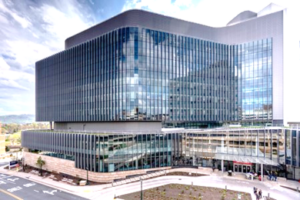 The new South Tower Expansion at the UVA hospital opened in April 2020 to accommodate the creation of a Special Pathogens Unit (SPU) dedicated to caring for patients with COVID. As our COVID case rate has dropped, these beds have been repurposed for use by our Hematology-Oncology and General Medicine services. The tower also features a new Emergency Department, additional operating suites, procedure rooms, labs, and radiology units, as well as 84 private patient rooms.
The new South Tower Expansion at the UVA hospital opened in April 2020 to accommodate the creation of a Special Pathogens Unit (SPU) dedicated to caring for patients with COVID. As our COVID case rate has dropped, these beds have been repurposed for use by our Hematology-Oncology and General Medicine services. The tower also features a new Emergency Department, additional operating suites, procedure rooms, labs, and radiology units, as well as 84 private patient rooms.
 Opened in 2017, the Education Resource Center (ERC) is conveniently located directly across from the main entrance of the UVA Medical Center. The ERC offers conference space and offices for Graduate Medical Education, where most conferences for the Internal Medicine Residency Program are held. The building also houses the Outpatient Pharmacy, which operates 24 hours a day, seven days a week, making it the only pharmacy within a 50-mile radius with around-the-clock service.
Opened in 2017, the Education Resource Center (ERC) is conveniently located directly across from the main entrance of the UVA Medical Center. The ERC offers conference space and offices for Graduate Medical Education, where most conferences for the Internal Medicine Residency Program are held. The building also houses the Outpatient Pharmacy, which operates 24 hours a day, seven days a week, making it the only pharmacy within a 50-mile radius with around-the-clock service.
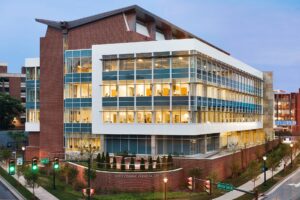 Opened in 2011, the five-story, 150,000-square-foot Emily Couric Clinical Cancer Center offers state-of-the-art therapies and comprehensive cancer care, all under one roof. As one of 70 National Cancer Institute-designated centers, UVA is part of a renowned group of leaders in cancer research, prevention, detection, and treatment. Our Stem Cell program has the highest level of accreditation, including Federation for Accreditation of Cell Therapy (FACT) and National Marrow Donor Program (NMDP)/Be The Match Registry approval.
Opened in 2011, the five-story, 150,000-square-foot Emily Couric Clinical Cancer Center offers state-of-the-art therapies and comprehensive cancer care, all under one roof. As one of 70 National Cancer Institute-designated centers, UVA is part of a renowned group of leaders in cancer research, prevention, detection, and treatment. Our Stem Cell program has the highest level of accreditation, including Federation for Accreditation of Cell Therapy (FACT) and National Marrow Donor Program (NMDP)/Be The Match Registry approval.
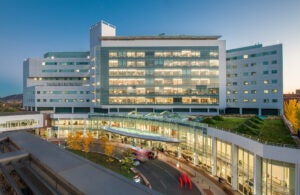 The opening of the North Unit Expansion of the University Hospital in 2012 added 72 ICU-capable private patient rooms and dedicated education space. The UVA Health System uses Epic, an electronic medical record (EMR) in use at more than 50 U.S. academic medical centers. A team representing all clinical areas selected this program for its usability and comprehensive documentation of a patient’s medical history and treatment.
The opening of the North Unit Expansion of the University Hospital in 2012 added 72 ICU-capable private patient rooms and dedicated education space. The UVA Health System uses Epic, an electronic medical record (EMR) in use at more than 50 U.S. academic medical centers. A team representing all clinical areas selected this program for its usability and comprehensive documentation of a patient’s medical history and treatment.
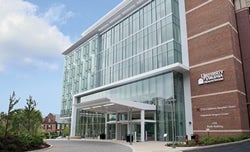 The Battle Building at the UVA Children’s Hospital was completed in the summer of 2014. This seven story, 200,000 square-foot facility houses pediatric primary care, dozens of pediatric subspecialty clinics, a maternal and fetal medicine clinic, pediatric outpatient rehabilitation services, the teen and young adult health center, outpatient surgery, a clinical trials suite, and clinical research office all in one location with immediate proximity to the UVA Medical Center.
The Battle Building at the UVA Children’s Hospital was completed in the summer of 2014. This seven story, 200,000 square-foot facility houses pediatric primary care, dozens of pediatric subspecialty clinics, a maternal and fetal medicine clinic, pediatric outpatient rehabilitation services, the teen and young adult health center, outpatient surgery, a clinical trials suite, and clinical research office all in one location with immediate proximity to the UVA Medical Center.
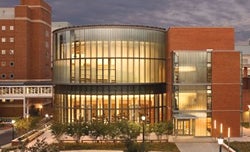 The 85,000-square-foot Claude Moore Medical Education Building serves as the central portal to the UVA School of Medicine, providing novel technologies and flexible teaching spaces to support innovative medical instruction. The facility features specialized multimedia classrooms, a Learning Studio, video-equipped exam rooms for analyzing student-patient interactions, and a Medical Simulation Training Center for refining skills.
The 85,000-square-foot Claude Moore Medical Education Building serves as the central portal to the UVA School of Medicine, providing novel technologies and flexible teaching spaces to support innovative medical instruction. The facility features specialized multimedia classrooms, a Learning Studio, video-equipped exam rooms for analyzing student-patient interactions, and a Medical Simulation Training Center for refining skills.
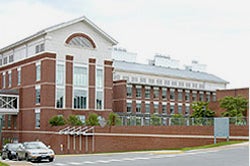 NIH support for medical research at UVA has grown significantly, and we are keeping pace with the quality of our laboratory space. The 150,000-square-foot MR5 Biomedical Engineering and Medical Science Building and the 102,000-square-foot MR6 Carter-Harrison Research Building house laboratories for more than 700 researchers and technicians in biomedical engineering, pathology, cardiovascular sciences, cancer, immunology, allergies, and infectious diseases.
NIH support for medical research at UVA has grown significantly, and we are keeping pace with the quality of our laboratory space. The 150,000-square-foot MR5 Biomedical Engineering and Medical Science Building and the 102,000-square-foot MR6 Carter-Harrison Research Building house laboratories for more than 700 researchers and technicians in biomedical engineering, pathology, cardiovascular sciences, cancer, immunology, allergies, and infectious diseases.
